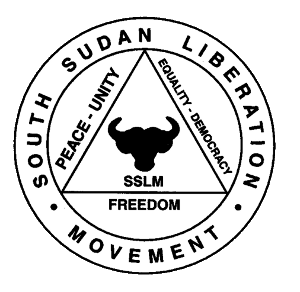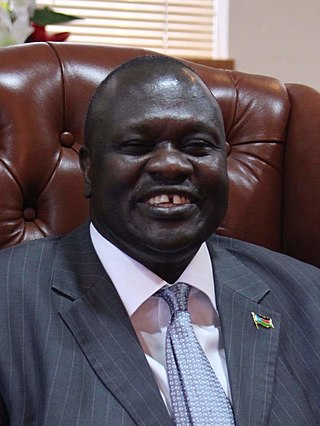Related Research Articles

The South Sudan Liberation Movement (SSLM) is an armed group that operates in the Upper Nile Region of South Sudan. The group's creation was announced in November 1999 by people of the Nuer ethnicity who were in both the rebel Sudan People's Liberation Army (SPLA) and the government-allied South Sudan Defence Forces (SSDF) gathered in Waat. The SSLM was declared to be unaligned in the Second Sudanese Civil War, then entering its sixteenth year. The name "South Sudan Liberation Movement" was decided upon the next year, borrowing from the earlier Southern Sudan Liberation Movement, which existed in the 1980s.

Riek Machar Teny Dhurgon is a South Sudanese politician who has served as the First Vice President of South Sudan since 2020.

Gabriel Gatwech Chan, better known by his nom de guerre Tanginye, was a South Sudanese military officer and rebel commander of various ethnic Nuer militant groups during the Second Sudanese Civil War and South Sudanese Civil War.
Peter Gatdet Yak, better known as Peter Gadet, was a South Sudanese general and SPLA commander who became the leader of the South Sudan Liberation Army (SSLA), a rebel movement in South Sudan.

Taban Deng Gai is a South Sudanese politician who has been one of the Vice Presidents of South Sudan in the unity government since February 2020. He served as the First Vice President of South Sudan from 23 July 2016 to February 2020. He was mining minister before being appointed as acting first vice president.
Paulino Matip Nhial, or Matiep Nhial, was a military leader and politician in South Sudan.
The Juba Declaration of 8 January 2006, formally the Juba Declaration on Unity and Integration between the Sudan People’s Liberation Army (SPLA) And the South Sudan Defence Forces (SSDF) 8 January 2006, laid out the basis for unifying rival military forces in South Sudan following the end of the Second Sudanese Civil War in January 2005.
Mayom County is an administrative division of Unity State in the Greater Upper Nile region of South Sudan. It is located to the west of Bentiu. The county headquarters is Mayom town.
Mankien is a community in Unity State in South Sudan. With a key location near the oil fields, the town changed hands more than once during the Second Sudanese Civil War (1983-2005). In April 2011 the town was once again the scene of conflict between militia and government troops.
Ethnic violence in South Sudan has a long history among South Sudan's varied ethnic groups. South Sudan has 64 tribes with the largest being the Dinka, who constitute about 35% of the population and predominate in government. The second largest are the Nuers. Conflict is often aggravated among nomadic groups over the issue of cattle and grazing land and is part of the wider Sudanese nomadic conflicts.

Block 5A is an oil concession in South Sudan. After oil field development began during the Second Sudanese Civil War, Block 5A was the scene of extensive fighting as rival militias struggled for control. Out of an original population of 240,000, an estimated 12,000 were killed or died of starvation and 160,000 were displaced by force. Production started in 2006. There is evidence that the environmentally sensitive marshlands beside the Nile are becoming polluted.
Koch County is an administrative division of Unity State in the Greater Upper Nile region of South Sudan, covering an area in the centre of the state.
Angelina Jany Teny is a South Sudanese politician who served as Minister of Defence since March 2020.
The South Sudan Democratic Movement (SSDM), sometimes called the South Sudan Democratic Movement/Army (SSDM/A), was a South Sudanese militant group. Along with its armed wing, the South Sudan Defence Army (SSDA), rebelled against the government of South Sudan led by President Salva Kiir Mayardit and the Sudan People's Liberation Movement.

The South Sudanese Civil War was a multi-sided civil war in South Sudan fought from 2013 to 2020, between forces of the government and opposition forces. The Civil War caused rampant human rights abuses, including forced displacement, ethnic massacres, and killings of journalists by various parties. Since its end South Sudan has been governed by a coalition formed by leaders of the former warring factions, Salva Kiir Mayardit and Riek Machar. In 2024, the country continues to recover from the war while experiencing ongoing and systemic ethnic violence.
The Unity State gubernatorial election took place on 11–15 April 2010, alongside the wider Sudanese general election, to elect the Governor of Unity State. Incumbent Governor Taban Deng Gai was re-elected, defeating 6 other candidates, including Angelina Teny, who had resigned from the SPLM in order to contest the election.
Peter Par Jiek was a brigadier general of the Sudan People's Liberation Army (SPLA), and veteran of the Second Sudanese Civil War. In the course of that conflict, Par fought under Riek Machar with several rebel and pro-government groups, and eventually became a powerful militia commander in Unity State. In that region, he established his own fiefdom and gained some notoriety for his rivalry with another rebel leader, Peter Gadet. Even though he had followed Machar during the whole Second Sudanese Civil War until 2005, Par sided with President Salva Kiir Mayardit upon the outbreak of the South Sudanese Civil War in 2013. Leading pro-government counter-insurgency forces in Wau State since 2014, Par was eventually ambushed and killed by SPLM-IO rebels loyal to Machar in 2017.

The South Sudan Defence Forces (SSDF) was a militia in South Sudan during the Second Sudanese Civil War (1983-2005) in uneasy alliance with the Government of Sudan.
The War of the Peters was a conflict primarily fought between the forces of Peter Par Jiek and Peter Gadet from June 2000 to August 2001 in Unity State, Sudan. Though both were leaders of local branches of larger rebel groups that were involved in the Second Sudanese Civil War, the confrontation between the two commanders was essentially a private war. As Par and Gadet battled each other, the Sudanese government exploited the inter-rebel conflict as part of a divide and rule strategy, aimed at weakening the rebellion at large and allowing for the extraction of valuable oil in Unity State. In the end, Gadet and Par reconciled when their respective superiors agreed to merge the SPDF and SPLA.

George Athor's rebellion was an uprising in the Southern Sudan Autonomous Region which lasted from April 2010 to December 2011. Organized by South Sudanese military commander and politician George Athor, the conflict mainly took place in the states of Upper Nile and Jonglei as well as some border areas.
References
- 1 2 3 4 "Gatluak Gai's Rebellion, Unity State" (PDF). Small Arms Survey. July 2011. Archived from the original on 2 April 2012. Retrieved 12 September 2011.
{{cite web}}: CS1 maint: bot: original URL status unknown (link) - 1 2 Bonifacio Taban Kuich (25 July 2011). "Militia Deputy Admits Killing of His Leader Gutluak". Sudan Tribune. Retrieved 12 September 2011.
- ↑ "Angelina Teny says she has no any connection with Gatluak Gai rebellion". South Sudan Net. 10 June 2010. Archived from the original on 2 April 2012. Retrieved 12 September 2011.
- ↑ Machien J. Luoi (18 November 2010). "Koch County Insurgency Is A National Security Issue" . Retrieved 12 September 2011.
- ↑ Mayank Bubna (6 January 2011). "UNITY STATE: SECURITY FEARS AMID REFERENDUM HOPES - PART 2". Relief Web. Retrieved 12 September 2011.
- ↑ "Update: South Sudan rebel leader Gatluak Gai killed in mysterious circumstances". Sudan Tribune. Juba. 23 July 2011. Retrieved 26 February 2013.
- ↑ James Copnall (23 July 2011). "South Sudan rebel Gatluak Gai killed after peace deal". BBC News. Retrieved 12 September 2011.